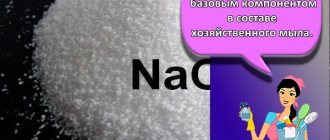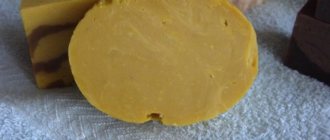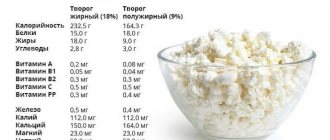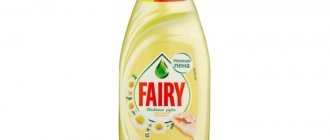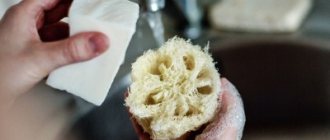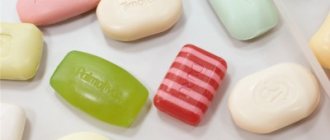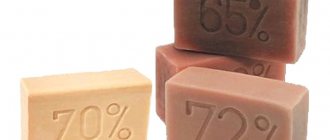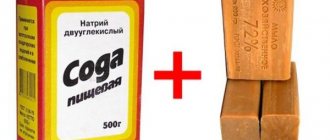How did laundry soap come about?
In Soviet times, there were three types of soap: laundry, bath (toilet) and children's. The household product was distinguished by the fact that it was good at washing various types of dirt. They washed floors and dishes with him. The brown block replaced all the household chemicals that are available now.
The first similar soap was born in Marseille (France) in the Middle Ages. Olive oil and salt were used to produce it.
In Russia, laundry soap is made from vegetable fats, oil, and salt. It is allowed to use fats of animal origin - lamb, beef, fish, pork. Due to its high alkali content, soap foam has a pronounced disinfecting effect - it prevents the growth of bacteria and promotes wound healing.
Kinds
Laundry soap contains increased amounts of acids and alkalis.
In the classic version, it looks like a rectangular brown bar with pressed numbers - 65, 70 or 72. They indicate the percentage of fatty acids. The higher the indicator, the better the soap copes with removing contaminants. According to the form of release, soap is distinguished:
- Liquid. Convenient to use, but may contain fragrances and synthetic detergents.
- Lumpy. Inexpensive and natural. The best grade is considered to be 72% soap.
- Powdery. Designed for washing thin and delicate fabrics, used in industry (in metallurgy for drawing wire).
The color of the soap can vary from light yellow to dark brown, depending on the degree of cleaning. The unrefined version smells stronger.
Top 5, “Cinderella” (liquid), “Spring”, “Agafya”, “Duru Clean&White”.
Advantages and disadvantages
There are legends about the beneficial properties of laundry soap. They not only wash and wash clothes, but also strengthen hair, treat ARVI, thrush, acne, and replace antiperspirant. Pediatricians advise washing newborn diapers, clothes and bedding for allergy sufferers with laundry soap. Unlike modern detergents, it never causes allergies.
Advantages:
- wide scope of application;
- low price;
- hypoallergenic.
Flaws:
- smell.
Some people describe the smell of laundry soap as smelling like feces. They categorically refuse to use it, despite all the advantages. To be fair, today there are products with fragrances that muffle the natural aroma. But often the better the soap smells, the more harmful chemicals it contains.
Properties
Each piece of soap, thanks to alkali, affects the surface of a person’s face with its acidic composition. Therefore, to reduce the impact of the alkaline component and neutralize it, acid is added to the product.
Soap has a number of useful properties:
- Helps soften the composition of water used for washing. Everyone knows for certain that the water in the tap has a high degree of hardness.
- Neutralizes various types of viruses, which is very useful during the cold season, during flu epidemics and other diseases.
- Relieves people from problematic acne, bacteria, boils, blackheads.
- Has antibacterial properties. Used for insect bites and allergic consequences.
- Helps quickly destroy fungus, regardless of where it occurs.
- An effective remedy against excessive sweating.
- Promotes the appearance of a soft, elastic skin surface, prevents it from drying out, helps in the treatment of wounds and cracks. This happens thanks to mink oil, which is part of the product, which is similar in composition to human tissue. It provides it with saturated fatty acids and essential vitamins.
- It does not contain any dyes, harmful additives or perfumes.
- It makes the surface of the face clean, copes well with oiliness, and gives a feeling of freshness.
What is tar soap used for?
The main area of application of tar soap is cosmetic. It is used:
- for the treatment of psoriasis and seborrhea;
- as an antiparasitic against lice;
- for various types of dermatitis;
- against inflamed acne;
- from black spots on the face;
- from hair loss.
The therapeutic effect is achieved due to the content of tar, a potent natural substance. It is obtained from birch bark by simmering in an airtight container. Tar has a pronounced antibacterial and anti-inflammatory effect, promotes the regeneration of damaged skin and improves blood circulation.
Important! Tar is an allergen. You need to use it carefully, observing the reaction. Signs of an allergy include redness and itching.
The product should not be used frequently due to its ability to dry out the skin. For a therapeutic effect, application 2-3 times a week is sufficient.
Kinds
Essentially, tar soap is a mixture of ordinary soap and tar. It contains up to 10% tar, the rest is a soap base: sodium salts of fatty acids, palm and other vegetable oils, water, sometimes fragrances, dyes. The composition of the product differs from different manufacturers. To reduce its cost, synthetic detergent components can be used.
The following types of tar soap are distinguished:
- Lumpy. Classic option. It looks like a brown bar with a pronounced tar smell. Its cost is affordable, and its composition is often as close to natural as possible.
- Liquid. Its main advantage is ease of use. As a rule, liquid tar soap foams better and smells nicer, but contains surfactants and various synthetic additives.
We recommend: Quartz or infrared heater – which is better to choose?
Top 5 manufacturers of tar soap: “Vesna”, “Nevskaya Kosmetika”, “Agafya”, “Kleona”, “Babushkina Pharmacy”.
Advantages and disadvantages
Tar soap stands out noticeably among other types of soap. Its undoubted advantages are:
- healing effect;
- affordable price compared to other cosmetic and medicinal products;
The disadvantages of the product include:
- specific smell;
- narrow scope of application;
- allergenicity.
The fat composition of the product corresponds to group 3 toilet soap. This means that its foam is weak and not stable. In addition, tar soap absorbs water well. It is not very convenient to use it as a detergent, as well as for household needs. It copes worse with dirt and leaves behind a tar smell.
The benefits of tar
An excellent HELP for problem skin - TAR SOAP!
Watch this video on YouTube
The main beneficial properties of tar-based soap are the following:
- Antibacterial action;
- Antifungal effect;
- Drying inflammation;
- Disinfectant effect;
- Activation of blood circulation;
- Strengthening cellular renewal and repairing damage;
- Mattifying effect, manifested in the normalization of the sebaceous glands;
- Lightening of pigment formations;
- Fighting post-acne;
- Acceleration of healing of dermatological damage.
Modern cosmetics are made using new technologies and improved formulas, which makes it possible to avoid such disadvantages of tar soap as a peculiar aroma and drying of the dermis. For sensitive and dry skin types, a use regimen that includes washing three to four times a week is suitable. This applies to the use of soap on the face. All other areas of the body can be well cared for using the product in question without any restrictions.
Tar has the property of forming a film on the surface of the skin that protects against external factors. This action of soap allows the dermis to recover and minimizes inflammatory processes.
To achieve clean and smooth skin on the surface of the shoulders, arms, legs and chest, a technique such as whipping soap foam and applying it to the body for ten minutes will help. This period of time is enough to dry out the rashes, as well as cleanse the pores. The more common method of wet use also gives excellent results, however, the longer the skin is in contact with the treatment, the better the effect is expected.
After completing the procedure, you must thoroughly rinse the product from the surface of the skin, pouring it generously with clean water or a decoction of medicinal herbs.
What is the difference between laundry soap and tar soap?
These two types of soap may be similar in appearance - both are dark in color, with a specific smell, in the lump version they are large bars. Photo:
But even with a remote external similarity between tar and laundry soap, the difference is clearly visible:
- Tar soap is darker, has a sharp tar smell, vaguely reminiscent of burning from a fire. Laundry soap is lighter in color, often has engravings with numbers, and has a special smell. Its smell is unlike anything else and is difficult to describe.
- Laundry soap has a wide range of applications; it can be used for washing, cleaning, disinfecting wounds, and in the garden. Tar soap is mainly used against dandruff, acne, skin diseases, and for hair care.
- Tar soap differs in composition - it contains birch tar. Laundry soap does not have such a component.
When to use
The main property of sulfur soap is directed against microbes and fungi. This allows it to be used in the treatment of many diseases in dermatology.
Hygienic procedures, as well as regular use of ointments, creams and medications that will be recommended for use by a doctor, will relieve a variety of skin diseases.
One of the indications for using sulfur soap is scabies. Itching and rashes bring a lot of trouble to a person.
But with proper care, you can get rid of unpleasant symptoms. Relieve dryness, peeling, get rid of compactions, return the skin to its normal condition.
With regular use, it copes with seborrheic dermatitis or dandruff. This disease is caused by fungi that thrive on the scalp. In advanced cases, pathology can spread to the body.
Rosacea is another indication. In this case, red spots or bumps appear on the body, which without treatment can be very noticeable.
Sulfur soap will help here too. It will relieve the inflammatory process, remove redness and reduce the number of rosacea.
If used regularly, you can significantly reduce the symptoms of these diseases.
comparison table
Those who have at least once used both soaps clearly understand the difference between them. We suggest comparing their characteristics in the table:
| Laundry soap | Tar soap | |
| Application area | Laundry washing, wet cleaning | Solving cosmetic and medical problems: acne, dandruff, psoriasis and others |
| Compound | Sodium salts of fatty acids, water, sodium chloride (salt). May contain bleaches, fragrances, preservatives, dyes | Sodium salts of fatty acids, water, sodium chloride (salt), birch tar. May contain fragrances, dyes, foaming agents |
| Kinds | 65%, 70%, 72%, liquid, solid, powder | lump, liquid |
| Smell | Sharp, specific, quickly disappears | Sharp, specific, long lasting |
| Additional properties | Effective for disinfecting wounds, controlling pests on plants, against inflammation of the skin | Helps against lice |
| Laundry | Removes stubborn stains and disinfects | Not usually used |
| Effect on skin | Reduces inflammation, cleans well, dries | Heals, cleanses, dries, relieves inflammation |
| Hypoallergenic | Yes | No |
| Main advantage | Inexpensive and effective product with a wide range of applications | Pronounced cosmetic and therapeutic effect |
| Main disadvantage | Smell | Not suitable for everyone (allergenic, smell) |
| Price for 200 g (ml) | 20-70 rubles | 35-250 rubles |
Mechanism of action on the skin
Human skin is always covered with a thin layer of sebum - a special substance produced by the sebaceous glands to protect the skin from moisture loss and from microbes entering the inner layers. Sebum traps dirt particles that fall on the skin, and since it is of a fatty nature, it exhibits hydrophobic properties, i.e., does not dissolve in it.
Soap is obtained as a result of the hydrolysis reaction of fatty acid esters with alkalis. This reaction is called saponification, resulting in the formation of alkali metal salts and alcohols. These substances, when combined with water, have surface activity, which makes it possible to use soap to cleanse the skin: it separates sebium and accumulated impurities from the surface of the dermis, so that they can then be removed together with water.
Each of the components of boric soap has beneficial properties, and in their harmonious combination they have a complex positive effect.
Which is better according to reviews?
Despite the large selection of modern products - detergents and cleaners, washing powders, cosmetics, tar and laundry soap are very popular. First of all, they are in demand among the older generation, who are familiar with the effectiveness of the products firsthand and have been using them since childhood.
First of all, buyers value naturalness in laundry and tar soaps.
The reviews do not compare them, so it is not possible to determine which is better. They are used for different purposes.
Reviews of tar soap
Tar soap is not suitable for everyone, so reviews about it are not always positive. You need to be prepared for a specific smell, and after washing, apply a moisturizer.
- Lena K.: “I recommend this product to all girls with problematic and oily skin. Tar soap really improves its condition, cleanses it incomparably (no other washes can compare), gets rid of acne and prevents the appearance of new ones. I use it to prevent rashes before menstrual periods. Helps out a lot!”
- Violetta: “I’ve been friends with tar soap for 30 years. Dandruff appears periodically since adolescence. As soon as my head starts to itch, I make a soap foam and apply it to the roots of my hair. After an hour I wash it off. I also like the tar shampoo “Psorilom”, but it costs more.”
- Ruslan: “It helped with rashes on the face as a teenager. But the smell is terrible.”
- Julia: “I read laudatory reviews and bought myself a bar of tar soap. I don't understand how people use it. I couldn’t comb my hair after washing, the whole skin on my face felt tight, and the smell was just something! I stood in the bathroom for two days and it was impossible to get in. I’m generally silent about my hair!”
- Ksyusha: “I’m 18 years old, and the pharmacy recommended tar soap for acne. I used it for a month and my face became clear. But it didn’t suit my mother because she has sensitive and dry skin.
- Marina: “Always lies in the bathroom in case a pimple pops up. And I even like the smell - natural, either tree bark or a fire. You just need to get used to it."
We recommend: Basic rules and important points when choosing toothpaste
Reviews of laundry soap
Laundry soap is often used along with modern household chemicals. Most people use it to wash socks and stubborn stains. Less common are those who use it for everything: washing dishes, washing the body, washing hair, cleaning the house, and gardening. Reviews from fans and opponents of laundry soap:
- Katya: “Tar, laundry soap is some kind of relic of the past. The stores are full of harmless household chemicals that do their job flawlessly. I’m generally silent about using it on the body and hair. They need nutrition and hydration, but soap only dries them out.”
- Olga: “I buy laundry soap “Effect 78%.” I love its smell. It reminds me of unrefined oil. I use it to wash underwear, socks, baby diapers, and remove stubborn stains. Works better than any stain remover."
- Oksana: “After I was diagnosed with allergic dermatitis to powders and gels, I began using laundry soap to wash dishes. At first it was uncomfortable, but then I got used to it. But my health is fine. It cleans and washes everything perfectly. And you don’t need to rinse it many times, everything creaks after the first time. Saving water."
- Sergey: “I use laundry soap against pests. Helps against aphids, thrips and any other scourge on plants.”
- Sasha: “I have laundry soap in my medicine cabinet. The doctor advised us to disinfect wounds with it, especially after bites from dogs, cats, or ticks. And just treat children’s broken knees.”
- Arina: “An irreplaceable thing for hand washing. It washes well. I don’t really like the smell, but it’s tolerable and dissipates quickly. It is also useful to wash with laundry soap for those with oily skin. It removes acne well. After a shower, all the pores open and the body breathes.”
How to treat papillomas on the face and neck with soap?
Laundry and tar soap are often used to treat many skin diseases. One of these is papillomas. Many people often develop large and small papillomas on their necks, fingers, and under their arms, which are not dangerous, but significantly worsen the condition of the skin and are simply a cosmetic defect. Many people develop complexes against this background. You can get rid of such rashes in a beauty salon.
Often, laser or cryodestruction, that is, freezing, is used for removal. But to remove papillomas in this way, you will need to shell out a decent amount of money, especially if the tumor is not a single one, but several or even dozens of them. If you wish, you can get rid of papillomas using laundry and tar soap.
Tar soap
Instructions for using laundry soap for papillomas:
- It is necessary to carry out the procedure at night. To do this, after a shower, the skin is lubricated with water using a cotton swab and rubbed with dry laundry soap on top.
- Try to use soap pointwise; for ease of application, you can simply moisten a cotton swab in water and rub it on laundry soap, and then generously lubricate the papilloma with the resulting slurry.
- Try not to lubricate the surrounding skin because soap can be very drying to the skin. It is on this action that the removal of papillomas is based. The manipulation must be carried out at night, for 3-4 days.
- It is necessary to monitor the general condition of papillomas. As soon as they become inflamed, red, swollen or itchy, you should stop using laundry soap. You should wash off this product early in the morning.
Try not to scratch, rip off or touch the papilloma with soap. Apply the product very carefully so as not to touch, damage or tear. If you accidentally touch a papilloma, several new formations may appear in its place.
Tar soap
Which soap is better
The benefits of both remedies are undeniable. But in order to choose the appropriate option, you should compare both according to the main characteristics:
| Characteristic | Economic | Degtyarnoe |
| Compound | Consists of animal fats of natural origin. | The main ingredient is birch tar. |
| Scope of application | Mainly used for washing clothes and cleaning various surfaces. It is also effective in combating certain diseases. | The main application is in cosmetology. Used as an antiseptic, regenerating, medicinal product. |
| Harm | With frequent use, it can cause allergic reactions and dry out the skin. | It can dry out the skin and washes off dye from colored hair. |
It is impossible to give a clear answer to the question - which soap is better. Each of them is good in its own way. Therefore, choosing the right product will depend on what you are going to use it for. So, tar soap is better suited for hygiene and treatment, disease prevention. Whereas household cleaners cope well with a variety of contaminants.
Recipes using boric acid
Increased sebaceous secretion causes acne. The pharmaceutical drug, boric acid, is an excellent disinfectant and cleansing agent. Does not have a pronounced smell or taste. Not addictive. Used individually and as part of recipes.
Chatterbox
To make homemade mash you will need the following ingredients:
- 30 ml. acids;
- 70 ml. camphor alcohol;
- 5 tablets of chloramphenicol or 10 tablets of streptocide.
Mix all the ingredients and the mash is ready to use! Apply directly to problem areas.
Lotion
Another lotion is made by mixing salicylic and boric acid with calendula tincture in equal proportions.
Ointment with water and glycerin
Take equal proportions of water, acid and glycerin. Apply the resulting dense mass onto the damaged areas. After drying, simply wipe with a towel or wash.
Benefits for hair
This remedy helps to defeat dandruff and relieve itching. Tar soap for hair has a drying effect, which helps eliminate oiliness, strengthens it, stimulates growth and prevents hair loss.
To prevent an unpleasant odor from remaining on your hair, you can use all kinds of masks, conditioners and balms. It is recommended to wash your hair with soft warm water. To soften hard water, you need to mix it with baking soda. The soap should be foamed and rubbed into the roots.
Perhaps the strands will become dull and difficult to comb. Then you can rinse them with water and vinegar or lemon juice or a herbal decoction.
Visible results from regular use of this soap will appear after 2 months. Many who wash their hair with this product for longer than 30 days switch to it forever, replacing shampoo with it. Girls notice that their strands become much softer, more manageable and silky.
